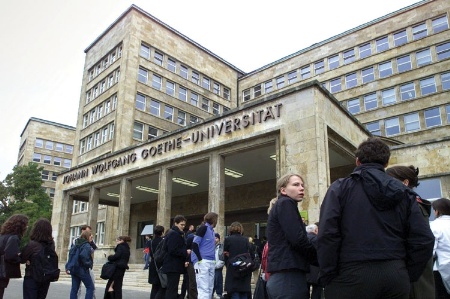Source: Dr David Prvulovic, Frankfurt
Forward thinking: Goethe University Frankfurt’s Campus Westend, here home to an exhibition of sculptor Igor Mitoraj’s work, is a modern glass complex designed to cope with increasing student numbers
Goethe University Frankfurt, established in 1914 as Frankfurt University, was the creation of a Jewish philanthropist and owed much of its growth to Jewish support and Jewish academics.
But under the Nazis, a third of its staff and students were forced out. The infamous Nazi scientist Josef Mengele, known as the “Angel of Death” for his activities at Auschwitz, was among its students.
Now the university is re-evaluating that history as it marks its centenary while also undertaking an ambitious agenda for change. In a country where universities are generally more closely linked to the state than in the UK, it has opted for more autonomy.
Other German universities may be older – such as Leipzig University (600 years old) or Ludwig-Maximilians University in Munich (more than 500 years old) – but Frankfurt, celebrating its centenary this year, has a unique history. Renamed in 1932 in honour of Johann Wolfgang von Goethe, Frankfurt’s most famous son, who died a century earlier, the university still has grand plans for the future.
“We aim to become ‘Harvard-on-Main’,” says Werner Müller-Esterl, who has been university president since 2009. “That’s our task for the next century,” he adds mischievously.
Over the past 15 years, the university has gradually relocated in large part to Campus Westend, a modern, light, glass complex in Frankfurt’s stylish west end. It is Germany’s “finest university campus”, says Müller-Esterl.
Together with the renovation of other, outlying complexes, the president feels that his university is geared to cope with the steady increase in student numbers predicted at German universities.
The price of autonomy
Yet not everyone shares his enthusiasm. “A lot of seminars and lectures are overcrowded,” says Daniel Katzenmaier, chairman of AStA-Uni FFM, the Goethe University Frankfurt students’ union. As many as 10 times the officially permitted number of students are squeezed into lecture halls, he adds.
Nor is he totally enthusiastic that it switched its funding structure in 2001, becoming Germany’s first major university to become a foundation university under public law. It is now only 60 per cent funded by regional taxpayers, with the rest coming from external fundraising and private grants.
The increased autonomy the university has enjoyed since is a good thing on the one hand, Katzenmaier says. However, he feels greater independence has come at a price: the university’s management has lost touch with the students and tends to take decisions over their heads. “It’s all about marketing these days, not issues,” Katzenmaier concludes.
Yet in becoming a foundation university again, Frankfurt was returning to its origins – in 1914, it was founded and financed as a private enterprise. It was the brainchild of Franz Adickes, then lord mayor of Frankfurt, and Wilhelm Merton, a Jewish industrialist and philanthropist.
Together, they created a university for the people that was largely founded and financed by prominent Jewish benefactors in the city of Frankfurt. The Rothschild banking dynasty contributed large sums, as did Moritz and Katharina Oppenheim, owners of a jewellery business in the city. To them all it was important that Jewish academics were given a chance to lecture and become professors at German universities.
“The Jewish benefactors had a liberal approach,” says Pascal Ballow, part of a group of Frankfurt history students researching the university’s origins. “On paper, Jews were equal citizens and had the same rights as everyone else,” he continues. “In practice, they could not teach at universities or become professors unless they converted to Christianity.”
The students are preparing an exhibition, expected to open in April, to commemorate and honour the Jewish citizens who sponsored and founded the university.
“This project has been an eye-opener for me,” says Erika Wagner, another member of the group. “I didn’t realise Frankfurt [University] owed so much to Jewish generosity and philanthropy,” she continues. “It’s time to say thank you, really.”
When Frankfurt opened its doors in 1914, it was the only institution not funded by Church or State. “It was a non-denominational university: that was important for the founders at the time,” says Katharina Busch, of the research group.
“That was particularly important for Jewish sponsors because Jews had been discriminated against a lot in the past, so it was a new beginning for them.”

Yet the first storm clouds were already gathering with the outbreak of the First World War: Kaiser Wilhelm II had to miss the university’s inauguration ceremony, while many students had already been called up.
In 1914, Frankfurt University had 618 students, and many Jewish scholars and professors. By 1923, student numbers had risen to 5,000.
Then, in 1933, the Nazis seized power in Germany. The university was a thorn in their side, infested as it was, from their point of view, with Jewish academics and Marxist revolutionaries. Fully a third of university students and staff were expelled once Hitler came to power.
Many emigrated to the US, including Max Horkheimer and Theodor Adorno, the leading lights of the “Frankfurt School” of sociology and philosophy. Meanwhile, the Oppenheims, upon learning that Jewish students and academics had been banned from studying and teaching there, committed suicide in June 1933.
Infamous alumnus
In a final, horrible twist Josef Mengele, the German army officer and medical doctor who carried out human experiments at the Auschwitz concentration camp, completed a PhD in medicine at Frankfurt in 1938 while working at the Institute for Racial Hygiene, which was attached to the university at that time.
There, he carried out “racial screening” tests to determine if people were of “Aryan” descent.
“A lot of people are unaware that Mengele was still seconded from the university up to 1944, when he was already in Auschwitz, carrying out gruesome experiments on concentration camp inmates, many of whom were children,” says Benjamin Ortmeyer, a professor who heads a research unit at the university focusing on how teaching methods and syllabuses were used to indoctrinate schoolchildren with Nazi propaganda after the party seized power (and how many teachers actively supported those efforts).
“The Goethe University centenary is not just about the good and famous, it’s about the infamous as well,” he adds. And he concludes by saying: “Of course, Mengele wasn’t the only Nazi at Frankfurt University at the time, but he is by far the best known.”
Ortmeyer’s team also runs seminars and hosts lectures featuring famous Holocaust survivors among the guest speakers, so teacher-trainee students can understand more about the Nazi period and how indoctrination and propaganda functioned during that time.
After the war was over, a number of Jewish émigrés, including Adorno and Horkheimer. returned to Frankfurt and academic life at the university.
Once again, Frankfurt’s pioneering spirit thrived. It was the first German university to establish a chair of economics, as well as being a centre of liberal thought – under Adorno and Horkheimer – that influenced the thinking of an entire generation.
However the university’s history after the end of the Second World War was not entirely trouble-free. In 1968, a wave of riots broke out at Frankfurt.
Students demanded more say in the running of the university, and the expulsion of academics who had been active during the Nazi period. In an unexpected turn of events, Adorno found himself having to call the police when students stormed the premises and occupied his Institute for Social Science Research out of hostility to his criticism of their violent protests.
Today, Goethe University Frankfurt has 45,000 students as well as 19 Nobel prizewinners to its credit, including physicist Otto Stern. But Müller-Esterl believes that there is still plenty of work to be done.
“We need to continue to attract sponsors and patrons if we wish to retain our status as a foundation university,” he says.
Even more importantly, he argues, the university must open up new fields of research so as to attract leading academics and maintain its reputation.
“The next 100 years will see a change in the way academics interact,” Müller-Esterl says. “Areas of expertise must be interlinked, so we all profit as much as possible from each other’s knowledge.”
Register to continue
Why register?
- Registration is free and only takes a moment
- Once registered, you can read 3 articles a month
- Sign up for our newsletter
Subscribe
Or subscribe for unlimited access to:
- Unlimited access to news, views, insights & reviews
- Digital editions
- Digital access to THE’s university and college rankings analysis
Already registered or a current subscriber?





